1 Volumes
Regional Overview: The Sights of the City, Loosely Defined
Philadelphia,defined here as the Quaker region of three formerly Quaker states, contains an astonishing number of interesting places to visit. Three centuries of history leave their marks everywhere. Begin by understanding that William Penn was the largest private landholder in history, and he owned all of it.
Up the King's High Way
New Jersey has a narrow waistline, with New York harbor at one end, and Delaware Bay on the other. Traffic and history travelled the Kings Highway along this path between New York and Philadelphia.

If you're serious about exploring the northerly rim of local Revolutionary history, you should take several days to do it, starting with a trip up the old King's Highway in New Jersey. That would take you from Cooper's ferry (Camden), to Haddonfield, Moorestown, Mt. Holly, Bordentown, Burlington, Lawrenceville, Princeton, New Brunswick, and Perth Amboy -- and then make a sixty-mile side trip to Morristown, where Washington wintered after chasing the British from Trenton back to winter quarters in New Brunswick. That would be a good place to stay overnight, unless you want go on to New York, or to make a hard three-hour trip down the New Jersey Turnpike to Philadelphia.
Having thus made a one-way drive up the main artery of colonial New York-Philadelphia traffic, you ought to link it with a second day of touring, either down the New Jersey coastline to Cape May, or across the remote hinterlands that the colonial guerillas had to follow to avoid the British. That would involve going to Somerdale (where Doris Duke has a show garden to visit), Hopewell (where you can see the scene of the Lindbergh baby kidnapping), over Washingtons Crossing, to Moland House, Doylestown, Valley Forge.
Perth Amboy Revisited
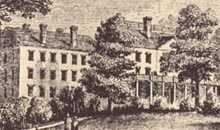
|
| Perth Amboy |
It's now moderately complicated to find Perth Amboy, New Jersey, even after you locate it on a map. Like New Castle DE it flourished early because it was on a narrow strip of strategic land, and like New Castle, eventually found itself cut off by a dozen lanes of highways crowded together by geography. It's an easy drive in both cases only if you make the correct turns at a couple of crowded intersections. Both towns were important destinations in the Eighteenth century, but by the Twentieth century, both were pushed aside by traffic rushing to bigger destinations. Industrialization hit the region around Perth Amboy somewhat harder than New Castle, destroying more landmarks, and bringing to an end its brief flurry as a metropolitan beach resort. If you aspire to preserve your Eighteenth-century glory, it's easier if you don't have too much progress in the Nineteenth. In Perth Amboy's defense, it must be noted that Jamestown and Williamsburg, Virginia had just about totally disappeared when noticed by Charles Peterson and John Rockefeller, but neither of those towns was run over by Nineteenth century industrialization. So, while New Castle has treasures to preserve and display, Perth Amboy seems to have only the Governor's mansion like the one notable building to work with. William Franklin, the illegitimate son of Benjamin, was the royal governor installed in this palace shortly before 1776.

|
| Governor's mansion in Perth Amboy |
While it is true that some wealthy local inhabitants did a lot to restore and maintain New Castle (and Williamsburg), the Governor's mansion in Perth Amboy was bought and made the home of Mathias Bruen, who is 1820 was thought to be the richest man in America. If Bruen had only had the necessary imagination and generosity, this was probably the best moment for Perth Amboy to have had a historical restoration. Instead, he added some unfortunate features to the mansion; it later became a hotel, and later on, an office building. Public-spirited local citizens are now trying to set things right, but the costs are pretty daunting. Someone has to find an inspired Wall Street billionaire like Ned Johnson to make over an entire town. Occasionally, a state government will do it, as has been done with Pennsbury. Or a national organization might become inspired, as happened with Mt. Vernon and Arlington. Its present state of peeling paint and makeshift repairs suggests uninterest in Perth Amboy's Governor Mansion by the State, and the absence of whatever it is that occasionally inspires fierce and determined local leadership. Perth Amboy needs some help and needs to forget about its handicaps. Sure, it's hard to commute anywhere, it's even hard to drive across the highways to the countryside. The bluff on the promontory was once quite arresting, now a rusting steel mill occupies that spot. Other than that, it doesn't look ominous or dangerous at all. It's just forgotten.
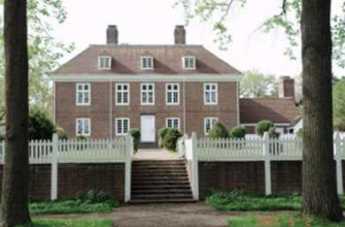
|
| Pennsbury Mansion |
Aside from the Royal Governor's former mansion, it is hard to find a historical marker or monument in this scene of former prosperity and glory, but there is one. Down on the beach is a bronze plaque, commemorating the 150th anniversary of the founding of -- Argentina. So there's a clue, which is not difficult to associate with all of the Hispanic names on the stores, and the Hispanics in evidence on all sides. They all seemed to know that this was once the capital of New Jersey, seemed pleased with it, and could point out the famous building. They are pleasant and friendly enough. Perhaps even a little too comfortable. Because, as William Franklin's famous father once said, all progress begins with discontent.
Trenton's Tomato Pie Cult
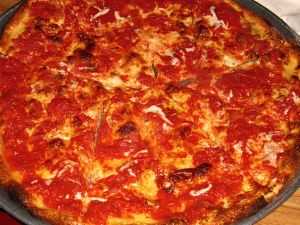
|
| Trenton's Tomato Pie |
The ingredients of a pizza pie are so simple it comes as a shock to learn the Italian community of Trenton, New Jersey, is fanatic about putting the cheese on the dough first, and then tomatoes on top. That's the way an authentic Trenton pizza is supposed to be made, rather than the conventional method of tomatoes first, cheese on top. To emphasize the point, these pizzas are determinedly referred to as tomato pies. And to tell the truth, there is a minor difference in the taste of the product made that way. As this more or less trivial issue is dissected and debated in great detail, an important fact about ethnic food emerges.
Be patient while each ingredient is examined. The crust will rise more in the warm summer than the winter, so it's thicker after it's baked. There is a faint fermentation taste which is more pronounced with a thick crust, but everyone in Trenton agrees this is a minor point. Everyone is also in agreement that most brands of Mozzarella cheese taste about the same. Tomatoes with seeds or without, or homogenized or chunky, make a minor difference. What is ultimately the essence of a Trenton tomato pie is that the cheese is put on top of the dough first, the tomatoes next spread on top, and the pie is then baked in the oven? Not everyone would notice the difference in taste, but it's definite, and in Trenton it's important. However, the locally acknowledged historian states his opinion that the thing that makes Trenton pies distinctive is not the ingredients, but the customers.
The employees of the shop know and respect the regulars, who tend to come to the same shop at least once a week, and call out the bakers by name as they enter. When they order a tomato pie, they give the name meaningfully, almost threateningly. According to the local historian, when the sons and grandsons of the shop owners move out to the suburbs and start a pizza shop in the strip mall, it isn't long before the tomatoes go on first, cheese on top. That's the way teenagers in the burbs are used to pizzas, and that's the way they expect to get them. As John Wanamaker used to say, the customer is always right, so the social rule which emerges is that ethnic food is not shaped by ethnic cooks, but by ethnic customers. To carry the idea a step farther, ethnic food isn't food, it's the old school tie.
Burlington, Capital of the Province of West Jersey
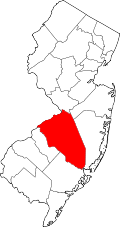
|
| Burlington County Map |
Perth Amboy sits on a high bluff overlooking New York harbor bordering the north side of the Raritan River, while Burlington sits on a high bluff overlooking Delaware Bay from the south. Each of them was originally the capital of a province. The eighty-mile strip of land between them is the wasp waist of New Jersey (Nova Caesaria) containing enough land to satisfy the needs of the handful of early settlers. This strip, as the shortest land distance between Delaware and the Hudson, seemed destined to be the commercial main line along the Atlantic seaboard. Ultimately, Scottish Quakers were comfortable moving into hilly East Jersey stretching to the northward on what used to be mainland; while the English Quakers were comfortable with the flat sandy loam stretching to the south into the piney woods that once were an oceanic barrier island. George Fox, the founder of Quakerism, had visited the area in 1671 and pronounced favorably on the fair prospect around Bridlington, now Burlington; the founding meeting of the two Quaker proprietorships was held there. Because of dissension within East Jersey, Queen Anne combined the two provinces into a single royal colony in 1701, with its colonial capital in Perth Amboy. The state capital moved to Trenton in 1790, following which the whole region prospered in response to the nation's first commercial railroad, the Camden and Perth Amboy RR. Ultimately, the flaw in this project was that the early railroad easily crossed the narrow Raritan but came to a dead halt in Camden, where it could not hope to cross the mile-wide Delaware at Philadelphia. When the Pennsylvania Railroad crossed Delaware at Trenton, the century-long prosperity of New Jersey from Trenton to Camden was doomed to slow decay.
One enduring symbol of the commercial decline of Burlington is in the second largest restaurant in town, located within an imposing bank building, whose remaining bank vault door towers over the dining area, and is only the first-floor vault. Another one like it is on the second floor. This bank turned restaurant is at the corner of two broad intersecting business avenues, one traveling north-south with a railroad track down the center, and the other leading to the fine esplanade on the bluff above the dock area. Sheltering the old docking area is Burlington Island, large enough to contain a hundred-acre lake.
Just south of the main street to the river is a handsome and well preserved colonial street, just waiting to become the center of a second Williamsburg revival, but curiously containing a house used by General Ulysses S. Grant, and -- not so curiously -- the family seat of the Haines family who have loomed large over West Jersey for many -- perhaps thirteen or fourteen -- generations.
If you go back to the other main street, the one with the railroad tracks, there is a little open-air station used by riders of the light rail Riverline which has flourished beyond all expectation as a less expensive way to commute to New York. In six months of operation, the Riverline has exceeded the ridership prediction for ten years ahead, so it's easy to predict more trains will be purchased to accommodate increased traffic, and home construction for commuters is probably not long in the future as well.
Just across the road from this little station stands a tiny one-story building, next to several imposing Federalist style red brick homes. You have to look up at the medallion over the door to identify this building as the present home of the Proprietors of West Jersey. This particular building was built in 1919, replacing an older one which used to be across the street. Inside the Proprietor building, behind the walls of small bank vaults, were the invaluable historical documents and maps of the Proprietorship, dating back to the signatures of William Penn and other notables taught about in the schools of the region. There was the Quintipartite Deed, signed by three Quakers (Penn, Gawen Lorie, Nicholas Lucas) and both George Carteret and Edward Billinge, establishing the boundaries of East and West Jersey; and there was the document of Concessions and Agreements, one of the major precursors of the United States Constitution; the Tripartite Indenture, and various early agreements of land sales. After a frustrating effort at break-in, these documents were copied and the originals sent to the State Archives. It seems a great pity to lose the testimony to the public trust that came along with having three-hundred-year-old relics easily and simply available for public view, just by walking up and asking to see them. But these are signs of the times; the greatest warning came from the rifling of the Christopher Columbus museum in Boalsburg, Pennsylvania, where any passerby could honk his horn and ask to see the sea chest and crucifix that Columbus actually used on his voyages to the brave new world, that hath such creatures in it.
REFERENCES
| New Jersey, A Historical Account of Place names in the United States: Richard P. McCormick: ISBN-13: 978-0813506623 | Amazon |
Heron Rookery on the Delaware
 |
| Great Blue Heron |
When the white man came to what is now Philadelphia, he found a swampy river region teeming with wildlife. That's very favorable for new settlers, of course, because hunting and fishing keep the settlers alive while they chop down trees, dig up stumps, and ultimately plow the land for crops. As everyone can plainly see, however, the development of cities eventually covers over the land with paving materials; it becomes difficult to imagine the place with wildlife. But the rivers and topography are still there. If you trouble to look around, there remain patches of the original wilderness, with quite a bit of wildlife ignoring the human invasion.
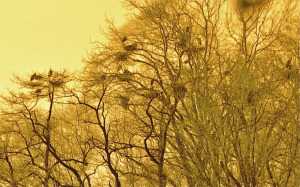 |
| Heron Nests |
Such a spot is just north of the Betsy Ross Bridge, where some ancient convulsion split the land on both sides of the Delaware River; the mouth of the Pennypack Creek on the Pennsylvania side faces the mouth of the Rancocas Cree on Jersey side. In New Jersey, that sort of stream is pronounced "crick" by old-timers, who are fast becoming submerged in a sea of newcomers who don't know how to pronounce things. The Rancocas was the natural transportation route for early settlers, but it now seems a little astounding that the far inland town of Mt. Holly was once a major ship-building center. The wide creek soon splits into a North Branch and a South Branch, both draining very large areas of flat southern New Jersey and making possible an extensive network of Quaker towns in the wilderness, most of whose residents could sail from their backyards and eventually get to Europe if they wanted to. In time, the banks of the Rancocas became extensive farmland, with large flocks of farm animals grazing and providing fertilizer for the fields. Today, the bacterial count of Delaware is largely governed by the runoff from fertilized farms into the Rancocas, rising even higher as warm weather approaches, and attracting large schools of fish. My barber tends to take a few weeks off every spring, bringing back tales of big fish around the place where the Pennypack and Rancocas Creeks join Delaware, but above the refineries at the mouth of the Schuylkill The spinning blades of the Salem Power Plant further downstream further thin them out appreciably.
Well, birds like to eat fish, too. For reasons having to do with insects, fish like to feed at dawn and dusk, so the bottom line is you have to get up early to be a bird-watcher. Marina operators have chosen the mouth of the Rancocas as a favorite place to moor boats, so lots and lots of recreational boaters park their cars at these marinas and go boating, pretty blissfully unaware of the Herons. Some of these boaters go fishing, but most of them just seem to sail around in circles.
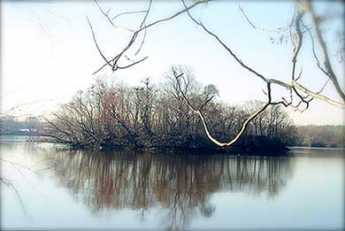 |
| As Seen From Amico Island |
Blue herons are big, with seven-foot wingspreads as adults. Because they want to get their nests away from raccoons and other rodents, and more recently from teen-aged boys with 22-caliber guns, herons have learned to nest on the top of tall trees, but close to water full of fish. And so it comes about that there is a group of small islands in the estuary of the Rancocas, where the mixture of three streams causes the creek mud to be deposited in mud flats and mud islands. There is one little island, perhaps two or three acres in size, sheltered between the river bank and some larger mud islands, where several dozen families of Blue Herons have built their nests. One of the larger islands is called Amico, connected to the land by a causeway. If you look closely, you notice one group of adult herons constantly ferries nest building materials from one direction, while another group ferry food for the youngsters from some different source in another direction. At times, diving ducks (not all species of ducks dive for fish) go after the fish in the channel between islands, with the effect of driving the fish into shallow water. The long-legged herons stand in the shallow water and get 'em; visitors all ask the same futile question -- what's in this for the ducks? The heron island is far enough away from places to observe it, that in mid-March its bare trees look to be covered with black blobs. Some of those blobs turn out to be heroes, and some are heron nests, but you need binoculars to tell. When the silhouetted birds move around, you can see the nests are really only big enough to hold the eggs; most of the big blobs are the birds, themselves. There are four or five benches scattered on neighboring dry land in the best places to watch the birds, but you can expect to get ankle-deep in the water a few times, and need to scramble up some sharp hills covered with brambles, in order to get to the benches. In fact, you can wander around the woods for an hour or more if you don't know where to look for the heron rookery. Look for the benches, or better still, go to the posted map near the park entrance south of the end of Norman Avenue. There are a couple of kiosks at that point, otherwise known as portable privies. Strangers who meet on the benches share the information supplied by the naturalists that herons have a social hierarchy, with the most important herons taking the highest perches in the trees. That led to visitors naming the topmost herons "Obama birds", and the die-hard Republicans on the benches responding that the term must refer to dropping droppings on everybody else. That's irreverent Americans for you.
There is quite a good bakery and coffee shop just north on St. Mihiel Street (River Road), and the new diesel River Line railroad tootles past pretty frequently. That's the modern version of the old Amboy and Camden RR, the oldest railroad in the country. It now serves a large group of Philadelphia to New York commuters, zipping past an interesting sight they probably never realized is there because they are too busy playing Hearts (Contract Bridge requires four players, Hearts are more flexible). However, there's one big secret.
The birds are really only visible in the Spring until the trees leaf out and conceal them. Since spring floods make the mud islands impassible until about the time daylight savings time appears, there remains only about a two-week window of time to see the rookery, each year. But it is really, really worth the trouble, which includes getting up when it is still dark and lugging heavy cameras and optics. Dr. Samuel Johnson once remarked that while many things are worth seeing, very few are worth going to see. This is worth going to see.
And by the way, the promontory on the other side of the Rancocas is called Hawk Island. After a little research, that's very likely worth going to see, too.
Battle of Monmouth
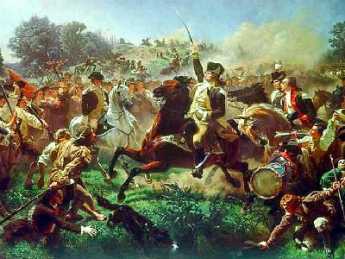
|
| Battle of Monmouth |
A moving army tends to get strung out on roads through unfamiliar territory, and when boarding ships leaves a steadily diminishing rear guard to protect the fleet. Thus, General Clinton's retreating British army presented an opportunity for Washington to harass them, take advantage of unexpected delays, and to be wherever they were going. So Washington ordered the Continental Army out of Valley Forge, to pursue the retreating British as they moved over the Delaware River to Camden, joining the King's Highway at Haddonfield, heading for Sandy Hook and the waiting ships of the British Navy. As both armies approached Monmouth Court House, Washington caught up with Clinton and ordered his deputy, General Charles Lee, to attack with an advance force that would hold the British in place until Washington's main force could catch up. Both armies had about 13,000 soldiers in strength, but only 9,000 of Clinton's men were engaged because of their strung-out deployment.
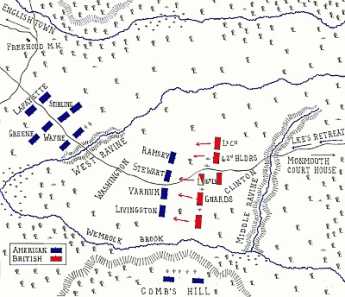
|
| Battle of Monmouth Map |
Washington's battle plan was therefore vindicated, and the next showed his characteristic ability to use terrain to his advantage. The New Jersey countryside breaks up into hills as it approaches New York harbor, and its valleys between hills tend to contain creeks at the bottom. Therefore, the retreating British were forced into narrowing valleys which exposed them to flanking maneuvers but reduced the room for Washington to be outflanked. Lee failed to take such effective advantage of the terrain and made only half-hearted attacks on the British. When Washington and the main body of troops caught up with him, Lee was promptly relieved of command and later court-marshaled. In his place, Washington sent Nathaniel Greene around the enemy's southern flank, setting up four artillery pieces on a high hill, protected from British attack by a flooded creek. He was thus able to "enfilade" the British line, aiming cannonballs at the near end where they would bounce up the British line if they fell short, or land in the far end of the British line when they overshot. The cannons now look fairly small and puny, but with a well-trained crew of a dozen artillerymen, each one could get off five to ten shots a minute. With four pieces of artillery, they could drop twenty to forty shots a minute onto the confused and compressed formation of enemy troops. The battle went on all day, the longest battle of the Revolution.
Under the cover of darkness, Clinton withdrew his troops toward Sandy Hook, leaving six hundred casualties on the ground, two-thirds of the British. The British could claim they achieved their objective of reaching the ships, but with greater casualties, and forced to withdraw in the face of discovering a much better-disciplined American army than they had ever faced. They acquired a new respect for Washington, who demonstrated boldness and outstanding tactics, with professionalism quite equal to their own.
REFERENCES
| New Jersey in the American Revolution: Barbara J. Mitnick: ISBN-13: 978-0813540955 | Amazon |
The King's Road
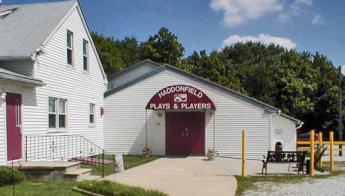
|
| Plays and Players of Haddonfield |
Harry Kaufman may not have started the Plays and Players of Haddonfield, but he certainly sparked it to a near-professional level in a town of 7000 people. The orchestra and the ballet company are particularly outstanding at the moment, the soloists on the stage quite good, although they never made the grand European tour which is thought to be the prerequisite for getting into the big time. Harry was the life of any party, and particularly good at composing little ditties, never quite getting around to stringing them together into a musical comedy until the 250th anniversary of the town. Even then, it is recalled he was shy and reluctant and had to be pushed a little. Since The King's Road appeared shortly after Oklahoma! transformed, even revolutionized, American musical comedy, it was not only the model but the stimulus for a similar comedy celebrating the beginnings of our little state. The plot was a simple one of a conflicted love affair. The striking innovation of Oklahoma! was to crowd most of the show's songs into the first act, repeating snatches of their themes as sort of Wagnerian background commentary throughout the remainder of the play. The other innovation of what was originally called Green Grow the Lilacs was the addition of Agnes DeMille's ballet company to emphasize the real historical theme with light-hearted music. Since I was one of the original reviewers for Oklahoma! in its New Haven tryouts, I can remember the revolutionary impact of that play, very well.
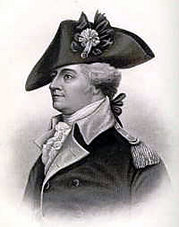
|
| Anthony Wayne |
Harry had to go to the Historical Society for authentic details of the conflict between the attraction for Revolutionary aspirations for Liberty, and loyalty to the earlier sufferings of Quakers for their pacifist leanings. Some Quakers deserted their faith to join the Revolution, and other Quakers tried to convert the Hessian soldiers. And still, others were loyal to the King of England. The Revolution was almost won at this moment, as the British occupants of Philadelphia had abandoned their supplies to attack, and had to get to the British fleet, bottled up in the lower Delaware River by fortifications at Fort Mifflin and Fort Mercer on the Jersey side of the river. The Hessians had been sent to attack Fort Mercer from the rear, passing through Haddonfield and stopping one night before going on to what we now call National Park. While the Hessian officers were being entertained by John Gill with discussions of the futility of war, Jonas Cattell slipped out of town and ran to alert Fort Mercer of its danger. The guns of the Fort were turned around, and the defenders pretended not to notice the approach of the Hessians until they were ambushed and largely destroyed. If Fort Mifflin on the Pennsylvania side of the Delaware River could have held out, the starving British might have had to surrender, but that didn't happen. In any event, the New Jersey Militia did its part, and little Quaker Haddonfield helped them in a sort of characteristic Quaker way. With a ratta-tat-tat and a fiddly dee, the rag-tag swallow-tail Jersey Militia got all the credit.
The play does not emphasize that the State of New Jersey was founded at the Indian King Tavern during these commotions, or that General Washington starving at Valley Forge sent Mad Anthony Wayne to circle up and around Trenton to drive a herd of cattle back from Salem County, two hundred miles back to Valley Forge. The British sent Captain Simcoe down to Salem County to massacre the Quaker farmers who provided the cattle. These later developments are only mentioned in its anthem to "Generals Wayne, LaFayette, and Pulaski", and every good resident of Southern New Jersey is supposed to know what that is all about.
The Quaker historian Rufus Jones established the enduring tradition that this split is what ultimately reduced the Quakers from the dominant religious group to a small religious sect in the three states once owned by William Penn, Delaware, Pennsylvania, and New Jersey. Related to such turmoil was the claim that more battles of the Revolution were fought in New Jersey than in any other state; if you include the large privateer navy going to see from the Jersey Pine Barrens, that is probably true. And every twenty-five years or so, we have to put on a revival of "The King's Road", and just show 'em.
6 Blogs
Perth Amboy Revisited
 Perth Amboy was once the capital of New Jersey and the entry point of General Howe's invasion of the rebellious colonies. Except for one old building, you might never guess.
Perth Amboy was once the capital of New Jersey and the entry point of General Howe's invasion of the rebellious colonies. Except for one old building, you might never guess.
Trenton's Tomato Pie Cult
 The capital of New Jersey teaches an important lesson about ethnic food.
The capital of New Jersey teaches an important lesson about ethnic food.
Burlington, Capital of the Province of West Jersey
 At first, New Jersey had two provinces and two capitals, and Burlington was one of them.
At first, New Jersey had two provinces and two capitals, and Burlington was one of them.
Heron Rookery on the Delaware
 Two or three miles from Philadelphia City Hall, a large flock of Blue Herons with seven-foot wingspreads are nesting in the trees, largely unnoticed.
Two or three miles from Philadelphia City Hall, a large flock of Blue Herons with seven-foot wingspreads are nesting in the trees, largely unnoticed.
Battle of Monmouth
 The British Army evacuated Philadelphia in June 1778, retreated across the narrow waist of New Jersey for the safety of their Navy at Sandy Hook. Washington caught up with them at Monmouth and fought a very creditable battle.
The British Army evacuated Philadelphia in June 1778, retreated across the narrow waist of New Jersey for the safety of their Navy at Sandy Hook. Washington caught up with them at Monmouth and fought a very creditable battle.
The King's Road
 It's only been performed fifteen or twenty times, but Hayyr Kaufman's musical comedy captures the real spirit of Olde Haddonfield.
It's only been performed fifteen or twenty times, but Hayyr Kaufman's musical comedy captures the real spirit of Olde Haddonfield.